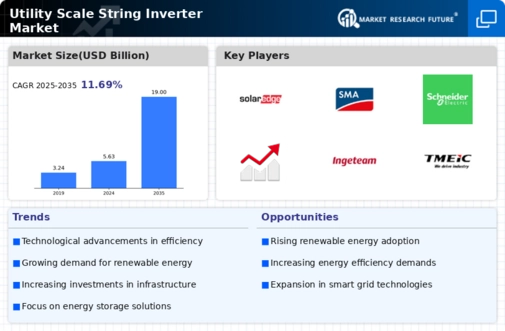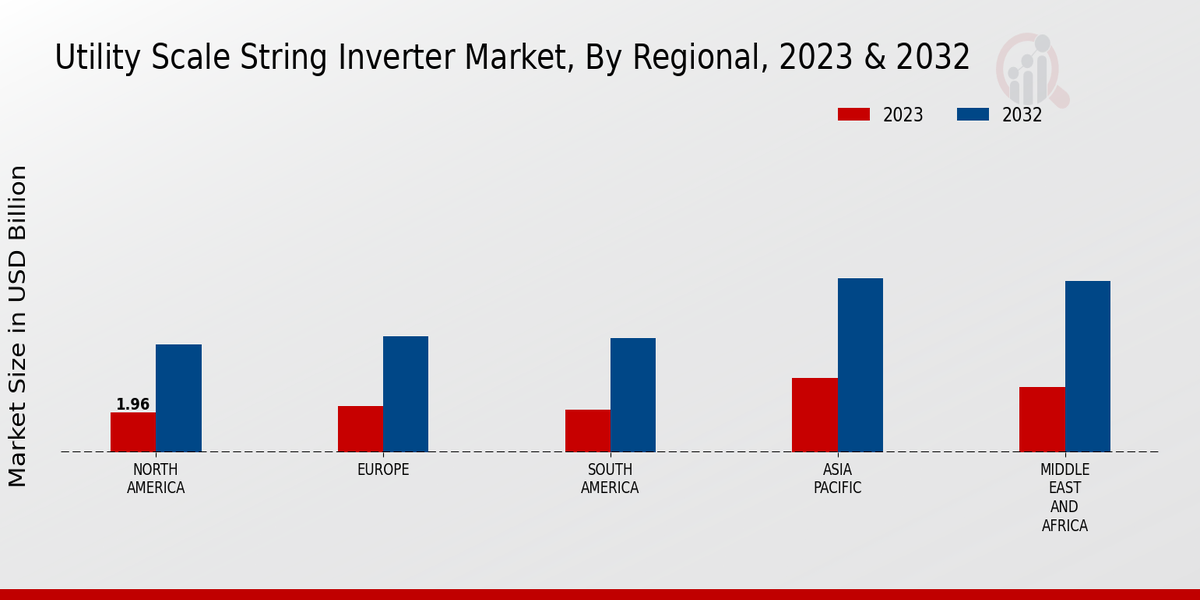Market Growth Projections
The Global Utility Scale String Inverter Market Industry is poised for substantial growth, with projections indicating a market size of 5.63 USD Billion in 2024 and an anticipated increase to 19.0 USD Billion by 2035. This growth trajectory suggests a compound annual growth rate (CAGR) of 11.69% from 2025 to 2035. Such projections reflect the increasing adoption of solar energy solutions and the expanding infrastructure to support large-scale solar projects. The rising awareness of climate change and the need for sustainable energy sources are likely to further drive this market, as stakeholders recognize the economic and environmental benefits of utility-scale string inverters.
Growing Energy Storage Solutions
The integration of energy storage solutions with solar power systems is emerging as a key driver for the Global Utility Scale String Inverter Market Industry. As the demand for reliable and consistent energy supply increases, the combination of string inverters with battery storage systems enhances the overall efficiency of solar installations. This synergy allows for better management of energy production and consumption, particularly during peak demand periods. The growing interest in hybrid systems is likely to propel the market forward, as stakeholders seek to optimize energy utilization. Consequently, this trend may lead to a more resilient energy infrastructure, further solidifying the role of string inverters in the renewable energy landscape.
Rising Demand for Renewable Energy
The increasing global emphasis on renewable energy sources drives the Global Utility Scale String Inverter Market Industry. Governments worldwide are implementing policies to reduce carbon emissions, thereby promoting solar energy adoption. For instance, in 2024, the market is projected to reach 5.63 USD Billion, reflecting a robust shift towards sustainable energy solutions. This trend is further supported by technological advancements that enhance inverter efficiency, making solar installations more economically viable. As countries strive to meet their renewable energy targets, the demand for utility-scale string inverters is expected to surge, contributing to a projected market growth rate of 11.69% CAGR from 2025 to 2035.
Government Incentives and Subsidies
Government incentives and subsidies play a crucial role in shaping the Global Utility Scale String Inverter Market Industry. Various countries offer financial support for solar energy projects, which lowers the initial investment barrier for developers. For instance, tax credits, grants, and feed-in tariffs can significantly enhance the economic feasibility of utility-scale solar installations. As a result, these incentives are expected to stimulate market growth, with projections indicating a market size of 19.0 USD Billion by 2035. Such supportive policies not only encourage the adoption of string inverters but also foster a competitive landscape that drives innovation and efficiency in the industry.
Technological Advancements in Inverter Design
Innovations in inverter technology significantly influence the Global Utility Scale String Inverter Market Industry. The development of more efficient and reliable string inverters enhances the performance of solar power systems. For example, advancements in power electronics and digital controls have led to inverters that can optimize energy conversion and improve grid integration. These technological improvements not only increase energy yield but also reduce operational costs, making solar projects more attractive to investors. As the industry evolves, the integration of smart technologies into inverters is likely to further enhance their functionality, thereby driving market growth in the coming years.



 Source: Primary Research, Secondary Research, Market Research Future Database and Analyst Review
Source: Primary Research, Secondary Research, Market Research Future Database and Analyst Review 

















Leave a Comment